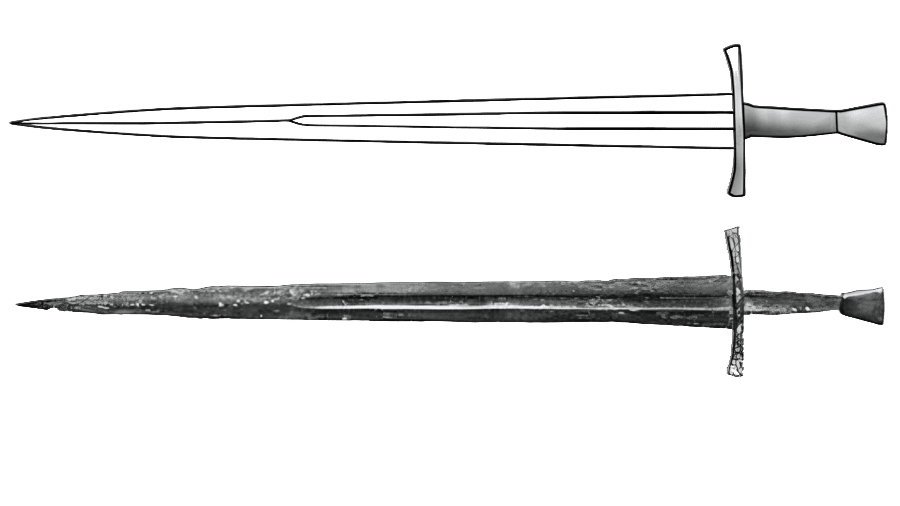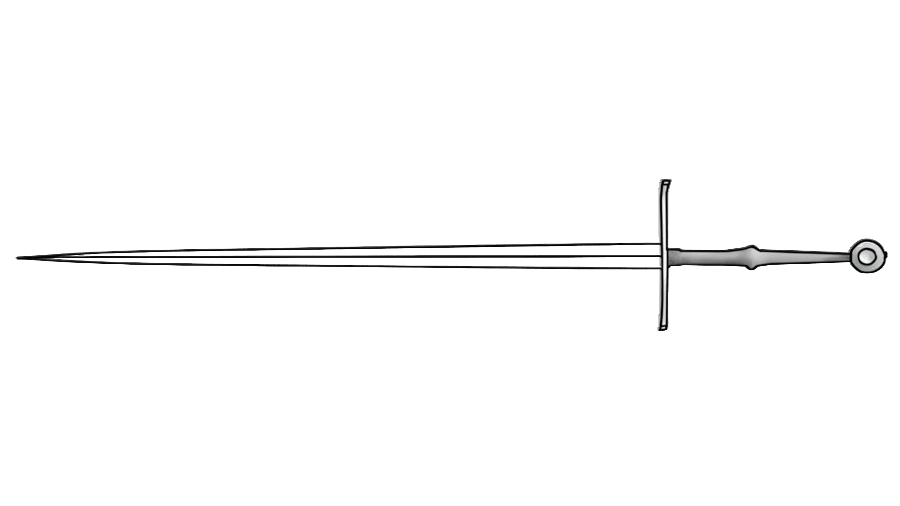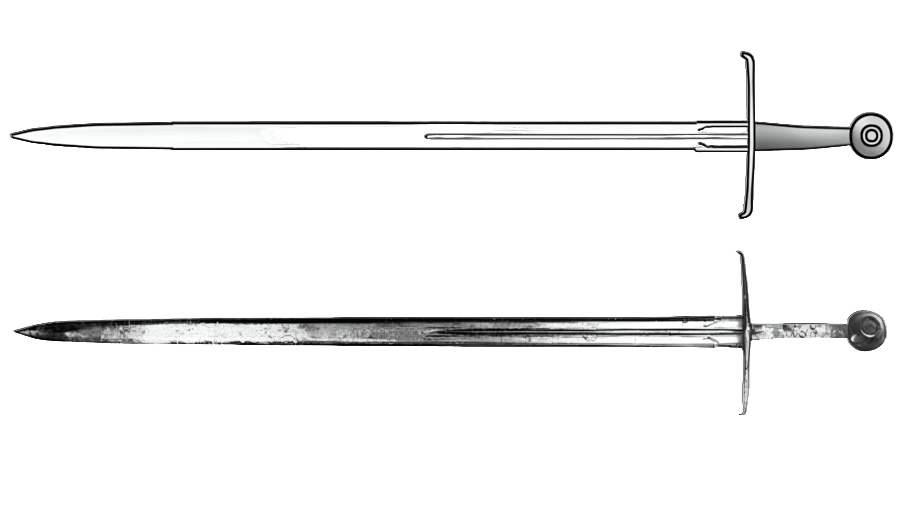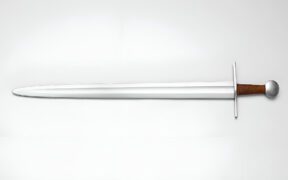Oakeshott Typology: Understand Medieval Sword Classification
NO AI USED This Article has been written and edited by our team with no help of the AI

Oakeshott’s Typology is a catalog and way to define European swords with double-edged blades, ranging from the late Viking era to the Renaissance. It makes it easier to refer to certain types of swords that resemble different groups based on several important factors.
This article will provide you with a simplified form of Oakeshott’s Typology. We will first explain who Ewart Oakeshott was and why he is so respected in the sword community today. Then, we will provide the different factors his typology is based on, the 13 different sword types he developed, and the individual sub-categories of double-edged European swords.
Who is Ewart Oakeshott?

Ronald Ewart Oakeshott was a British amateur historian, illustrator, and sword enthusiast who collected, researched, and studied medieval European arms and armor for over 60 years. He is credited with creating one of the most detailed sword classification charts known as the Oakeshott Typology.
Oakeshott’s passion for European swords and armor started at age four when his uncle, Jeffery Farnol, a British adventure romance novelist, introduced him to his wide collection of bladed weaponry, some over three centuries old. Ewart started his own collection accompanied by profound research of the many European blades he took hold of.
The research he conducted on the many historical European swords is evident in his books. Some of his most popular manuscripts include The Archeology of Weapons: Arms and Armour from Prehistory to the Age of Chivalry, The Sword in the Age of Chivalry, and Records of the Medieval Sword.
Oakeshott continued a sword classification system previously created by authors such as Elis Behmer about migration period swords, as well as Jan Peterson and Rober Mortimer Wheeler, who focused primarily on Viking swords of the Early Middle Ages, starting with types labeled from I to VII and then finishing with IX. The Oakeshott Typology starts with X (ten), ends with XXII (22), and includes variable medieval European swords.
Sword Type Factors

Previous typologies of European swords were primarily differentiated based on their hilts and pommels because the blades were similar in function and design. Oakeshott’s Typology broadens the horizon and is more complex due to the wavering of medieval swords with different characteristics yet similar designs.
Oakeshott based the swords of his typology on many different factors. Here are some of the most prominent:
- Period – what time in history the sword was or could have been used
- Pommel type – the design and form of the sword’s pommel
- Tang – the design of the blade’s tang underneath the grip
- Function – the specific purpose of a designed blade, whether used for cutting or thrusting
- Fuller – the length and form of the groove running through the center of the blade as well as its length
- Length – the length of the blade and overall sword that varied throughout history
- Grip – the different styles of grip and length that impacted the sword’s function
- Cross section – the different blade cross sections, such as hexagonal, diamond-shaped, and lenticular
- Blade profile (taper & point) – the overall design of the blade and the degree to which it narrows and the shape of the blade’s tip, whether pointed or acute
Oakeshott further divided swords into two main groups. Swords with blades meant to battle chainmail armor (X (ten) -XIV (fourteen)) featuring broader and more acute tips, and swords that were more effective against plate armor (XV (fifteen) -XXII (twenty-two)), which had stronger tapering and sharper tips.
The Oakeshott Typology

Oakeshott’s Typology helps differentiate double-edged European swords because, during the Middle Ages, historical scripts simply referred to them as “swords.” This made it difficult to narrow them down to the correct century. Single-edged or curved swords, such as the falchion and messer are not included in his typology.
It is important to note that even Oakeshott did not consider his typology complete or perfect. This explains why some swords may not fit inside a particular category or why some fit into more than one.
Type X (10)

- Function – cutting
- Historical period – 9th-13th centuries (900 – 1200)
- Blade profile – broad with a light taper toward a rounded blade tip
- Cross section – lenticular
- Average blade/grip length – 31 inches (79 cm) / 3.5 inches (9 cm)
- Grip – one-handed
- Fuller – wide fuller running for most of the blade’s length
- Tang – flat and broad with tapering to the pommel
The Oakeshott type X is a transitional sword with a strong link between the Viking sword of the Early Middle Ages, otherwise known as the Carolingian sword, and the early medieval arming sword also called the knightly sword. This blade type was a powerful chopping tool used by the Normans, Vikings, Anglo-Saxons, and European knights throughout the 15th century.
Sub Type Xa

The type Xa is almost identical to the X sword type, except for the fuller being slightly longer and narrower. The blade tapers to a fairly broad and rounded tip, making it very effective for cutting tests.
Type XI (11)

- Function – cutting
- Historical period – 12th century (1100 – 1175)
- Blade profile – narrower with a light taper to an acute blade tip
- Cross section – lenticular
- Average blade/grip length – 37 inches (95 cm) / 3.5 inches (9 cm)
- Grip – one-handed
- Fuller – same as X, but narrower
- Tang – broad but not as flat as X
The Type XI may look similar to the X sword but is a direct opposite. Where the X is broad, the XI is slimmer, longer, and slimmer toward the blade tip. This sword was frequently used by knights during the High Middle Ages, who rose to prominence during this time. Knights were almost always mounted and used the blade while on horseback. It was primarily a chopping tool but could have also been used for thrusts.
Sub Type XIa

XIa swords were very similar to the main XI type, with the biggest difference being that the blade was much broader than the XI type. Some examples discovered have slightly shorter blade lengths, while the fuller remains straight and ends close to the blade’s tip.
Type XII (12)

- Function – cutting
- Historical period – 12th – 14th centuries (1170 – 1350)
- Blade profile – broad at the neck, flat with light tapering to an acute blade tip
- Cross section – lenticular
- Average blade/grip length – 32 to 34 inches (81 to 86 cm) / 3.7 inches (9-10 cm)
- Grip – one-handed
- Fuller – 2/3 of the blade with a narrow fuller
- Tang – flat with almost parallel sides
The Type XII is the most popular medieval European sword known as the European arming sword. It was an upgrade of the previous blade types and could be used effectively on foot or horseback for chopping and thrusting. Its blade design is the archetypal knightly one-handed weapon mounted on various hilt fittings. Its blade started to taper during manufacturing, which was a sign of the production of plate armor.
Sub Type XIIa

The XIIa is very different than the XII, yet they follow the same blade design model. The biggest difference is that these swords were larger than the XII type. They could feature a blade as long as 38 inches (97 cm) with a grip that could be used as an early hand-and-a-half sword. The fuller is roughly the same size as the original, and the blade tapers almost identically.
Type XIII (13)

- Function – cutting
- Historical period – 13th-14th centuries (1240 – 1350)
- Blade profile – broad, flat with parallel edges that start tapering at the beginning and end with a rounded blade tip
- Cross section – lenticular
- Average blade/grip length – 30 to 35 inches (76 to 89 cm) / 5.9 inches (15 cm)
- Grip – one-handed, hand and a half
- Fuller – at least half of the blade
- Tang – thin with an almost square cross-section
The XIII swords were not commonly used as they were specialized tools of war. They featured early hand-and-a-half or two-handed grip lengths. Few remaining examples exist today. These sword types evolved during the Late Crusades, allowing for powerful slashing and chopping tools against contemporary armor.
Sub Type XIIIa

This subtype mirrors the same design and characteristics of the XIII, yet on a much grander scale, sometimes reaching a blade length of 40 inches (101 cm). These were functional early hand-and-a-half swords that were favored over the original type. Sometimes, this subtype was seen as a type of its own, referred to as the “medieval war sword.”
Sub Type XIIIb

While the previous sub-type was a larger war sword primarily used during battle due to its larger length, the sub-type XIIIb is the opposite in design but also a very functional weapon. This sword design features the same blade length as the primary XIII but has a much smaller one-handed grip. The XIIIb is a specialized arming sword most effective against chainmail during the Crusades.
Type XIV (14)

- Function – cutting and thrusting
- Historical period – 13th – 14th centuries (1275 – 1340)
- Blade profile – broad and flat with a sharp taper that ends with an acute tip
- Cross section – lenticular
- Average blade/grip length – 26 to 33 inches (66 to 84 cm) / 3.5 to 4.5 inches (9 to 11 cm)
- Grip – one-handed
- Fuller – 3/4 of the blade with a broad design
- Tang – thick and parallel-sided
The Type XIV features a broad, sharply tapered blade much shorter than other contemporary sword types. It was a fairly popular triangular-looking blade and is likely one of the last types of European swords designed to counter the very effective chainmail of the time. Sometimes, it is referred to as an early knightly broadsword due to its fairly broad blade shape.
Type XV (15)

- Function – thrusting
- Historical period – 13th – 16th centuries (1290 – 1515)
- Blade profile – broad beginning to a very strong taper ending with a sharp tip
- Cross section -flat diamond, hollow ground, reinforced midrib
- Average blade/grip length – 29 to 33 (74 to 84 cm) / 4 – 5.9 inches (10 – 15 cm)
- Grip – hand and a half, one-handed
- Fuller – none
- Tang – narrow with rectangular cross-section
The Oakeshott type XV is the first sword type in a group of European double-edged blades that were made to counter the rise in plate armor and pierce through earlier chainmail. These swords had longer, slimmer blades that tapered to a very sharp tip designed to slip through gaps in the enemies’ armor. The XV swords were among the most popular used during warfare and featured in many fencing combat manuals.
Sub Type XVa

The XVa sub-type swords were more common than their original type. These were the first bastard swords that could be used with one or two hands. Their grips were larger than the XV type, featuring the same blade characteristics with a reinforced midrib. They narrowed down to a very sharp tip, which made them effective in combat against contemporary plate and chainmail armor.
Type XVI (16)

- Function – thrusting
- Historical period – 14th century (1300 – 1350)
- Blade profile – broadened and flat with a very sharp taper ending with an acute tip
- Cross section – flat diamond
- Average blade/grip length – 28 to 32 inches (71 to 81) / 3.9 inches (10 cm)
- Grip – one-handed
- Fuller – one-half of the blade
- Tang – wide and flat with a rectangular cross-section
The Type XVI is an evolved form of the previous XV sword, which was made to be equally useful for powerful thrusting and cutting attacks on several armor types. The flat diamond shape with a wide fuller was commanding against plate armor. This versatile blade was favored by many in the 14th century during the height of the medieval weapons race against upcoming armor.
Sub Type XVIa

The XVIa type developed as a need for a longer version of the XVI with a strong tapered blade tip to counter the heavily increasing plate armor of the period. This sub-type had a hexagonal cross-section with a much shorter fuller. The grip was also larger, making it possible to use one or two-handed.
Type XVII (17)

- Function – thrusting
- Historical period – 14th-15th centuries (1335 – 1425)
- Blade profile – long and slender with a sharp tapered end with a pointed tip
- Cross section – narrow and stout hexagonal
- Average blade/grip length – 35 to 38 inches (89 to 97 cm) / 7.9 inches (20 cm)
- Grip – two-handed
- Fuller – shallow at the beginning of the blade
- Tang – stout with quadrangular section
The Type XVII was a sizable two-handed sword that evolved as a need against rising plate armor. Its sharp tip, combined with the brute force of wielding it with two hands, was capable of forcing its way through even a small gap in the opponent’s armor, often leading to injury. While some swords had stiff blades and could weigh more than 4 lbs (2 kg), they were meant to be used as impact blunt weapons against all types of armor. But some lighter swords were featured in fencing and fighting manuals.
Type XVIII (18)

- Function – cutting and thrusting
- Historical period – 15th – 16th (1410 – 1510)
- Blade profile – broad at the guard with a light taper toward a very sharp tip
- Cross section – flattened diamond, pronounced mid-rib, hollow ground
- Average blade/grip length – 27 to 36 inches (69 to 91 cm) / 4 inches (10 cm)
- Grip – one-handed
- Fuller – type XVIII has none, sub-types XVIIIa and XVIIIe have very narrow, short fullers
- Tang – rectangular
The Type XVIII is generally a smaller sword than the contemporary ones and was designed to be a fast and effective cut-and-thrust tool. This sword was favored because light armor was returning with the increase of powerful long-range projectile weapons, including adding goat foot levers to the crossbow, which required an adaptable blade rather than a weapon delivering a forceful impact. These many sub-types featured the same light cut and thrust design while having different lengths.
Sub Type XVIIIa

The XVIIIa has an almost identical design to the XVIII sword type. Where it differs, however, is the grip, which makes it usable with one or two hands. It also had a much more slender blade that could be ideal for slipping through the gaps in the enemy’s plate armor. Some featured a very slim fuller, which amounted to 1/3 of the blade’s length.
Sub-type XVIIIb

The sub-type XVIIIb was a much larger version of both previous designs. It was always a hand-and-a-half or two-handed weapon with a slim blade that tapered to an extremely sharp tip. Its blade could reach up to 42 inches (107 cm), and its more prominent grip made it an impressive longsword-type weapon.
Sub Type XVIIIc

The broader and tougher version of the XVIIIb was the XVIIIc. It featured the same design but with a thicker blade, making it excellent for chopping attacks. The length was slightly shorter, and some swords featured a small fuller to compensate for the heavier weight due to its broader blade.
Sub Type XVIIId

XVIIId sub-type swords are the slimmest version of the XVIII type. They have a stiff, long blade that can be used for slicing and thrusting. Their grips are shorter and usually one-handed, featuring various side rings or S-shaped crossguards. Some can have a fuller running through its entire length, while some have a reinforced mid-rib.
Sub Type XVIIIe

The XVIIIe sub-type was a popular sword design found mostly in regions of Denmark and Northern Germany. It featured a more significant grip length over the previous types, with a long and unusually narrowed ricasso at the beginning of its blade. The shape could often be a flattened diamond with a pronounced midrib.
Type XIX (19)

- Function – cutting and thrusting
- Historical period – 14th – 17th (1350 – 1600)
- Blade profile – sometimes broad or slim, always a hexagonal section with a light taper leading to the blade’s tip
- Cross section – flat hexagonal, chamfered edges
- Average blade/grip length – 32 to 34 inches (81 to 86 cm) / 3.9 to 5.9 inches (10 to 15 cm)
- Grip – one-handed, hand and a half
- Fuller – ricasso, long fuller
- Tang – rectangular
The Type XIX was a sword that was particularly favored as a secondary hanger used during the High Middle Ages well into the Renaissance. They encompassed several interesting cosmetics such as ricasso, aesthetic grooves, and useful and decorative rings. They were light, short, one-handed weapons used for cutting and thrusting.
Type XX (20)

- Function – cutting and thrusting
- Historical period – 14th – 15th (1350 – 1450)
- Blade profile – broad with almost parallel double edges that feature a very light taper ending with a sharp tip
- Cross section – lenticular or octagonal
- Average blade/grip length – 30 to 42 inches (76 to 107 cm) / 5.9 inches (15 cm)
- Grip – hand and a half, two-handed
- Fuller – shallow central, with two accompanying from the sides
- Tang – rectangular
The Type XX was the last true two-handed primary sword used on the battlefield. It was often enormous, with a two-handed grip and a fairly broad tapering blade, making it effective for cutting and thrusting attacks. Some of these could be considered bastards swords, while others were referred to as longswords.
Sub Type XXa

The XXa was a much shorter version of the XX type. It was no longer than 34 inches (86 cm) and featured a more acute blade profile. This sub-type had the same smaller fuller models, but its blade tapered narrowly toward an extremely sharp tip. Its grip was also smaller but could be used effectively with one or two hands.
Type XXI (21)

- Function – cutting and thrusting
- Historical period – 15th – 16th (1450 – 1560)
- Blade profile – broad with a very slow taper ending with an acute tip
- Cross section – hexagonal
- Average blade/grip length – 28 to 34 inches (71 to 86 cm) / 3.5 inches (9 cm)
- Grip – one-handed
- Fuller – multiple fullers through half or the entire length of the blade
- Tang – rectangular
The XXI type is a transitional sword design that took some blade elements from the Late Middle Ages and the beginning of the Renaissance. It is a civilian-type cinquedea sword with a broad blade tapering to a sharp tip, making it the ideal defensive or offensive weapon. These swords were often highly decorated, featuring many fullers, engravings, and different inlays, making them an important status symbol.
Type XXII (22)

- Function – cutting and thrusting
- Historical period – 15th-16th (1440-1570)
- Blade profile – broad, flat blade with a slow taper to a sharp tip
- Cross section – flattened diamond, hexagonal
- Average blade/grip length – 26 to 40 inches (66 to 101 cm) / 3.5 inches (9 cm)
- Grip – one-handed
- Fuller – 1/3 of the blade with usually two short and deep fullers
- Tang – rectangular
The Type XXII is a blade similar to the XXI that was developed about ten years earlier. It was also a transitional sword between the Late Middle Ages and the Renaissance, with few surviving examples today. Though the XXII was generally a smaller sword, some examples were massive in proportion. Some see them as war tools, while others mark them as ceremonial tools such as bearing or parade swords.





